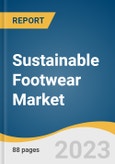The global sustainable footwear market size was estimated to reach USD 12.96 billion in 2030, registering a CAGR of 6.3% from 2024 to 2030, according to a new report. Over the past decade, consumers have become increasingly aware of the environmental impact of their purchasing decisions. They are more conscious of the materials used in products, their sourcing, and the carbon footprint associated with their production. This heightened awareness has led many consumers to seek eco-friendly alternatives, including footwear.
Innovations in sustainable materials, such as recycled plastics, organic cotton, and renewable materials like bamboo or cork, have enabled footwear manufacturers to create products that align with eco-friendly values. In addition, eco-conscious production methods, such as reduced waste, energy efficiency, and ethical labor practices, have become more prevalent in the industry.
Non-athletic footwear is in high demand across the globe. This significant market presence can be attributed to the rising trend of consumers actively making socially responsible fashion choices, thereby fueling the demand for non-athletic sustainable footwear options. Furthermore, the expanding variety of sustainable casual shoe offerings for women and men is pivotal in propelling market growth. Due to the ongoing innovations in sustainable materials, including the use of recycled and vegan materials, fashion brands now have the means to craft fashionable and environmentally-conscious footwear alternatives.
The growth of the men's sustainable footwear segment is primarily driven by the growing interest in sustainable athletic footwear and related technological advancements, which are spurring demand among male consumers. The rising participation of men in sports and fitness activities is also a driving force behind the increasing demand for sustainable athletic footwear. To cater to this trend, athletic footwear manufacturers continually enhance their product offerings, focusing on innovation and sustainability to align with the preferences and values of active male consumers. In response, athletic footwear producers are introducing innovative and sustainable choices tailored specifically to the needs and ideals of active men.
In Asia Pacific, the progress in sustainable material sourcing and manufacturing methods has facilitated the production of environmentally friendly footwear without compromising affordability. Governments in this region are also actively addressing environmental issues by implementing regulations and incentives to promote sustainability in manufacturing processes and products, including footwear.
This product will be delivered within 1-3 business days.
Innovations in sustainable materials, such as recycled plastics, organic cotton, and renewable materials like bamboo or cork, have enabled footwear manufacturers to create products that align with eco-friendly values. In addition, eco-conscious production methods, such as reduced waste, energy efficiency, and ethical labor practices, have become more prevalent in the industry.
Non-athletic footwear is in high demand across the globe. This significant market presence can be attributed to the rising trend of consumers actively making socially responsible fashion choices, thereby fueling the demand for non-athletic sustainable footwear options. Furthermore, the expanding variety of sustainable casual shoe offerings for women and men is pivotal in propelling market growth. Due to the ongoing innovations in sustainable materials, including the use of recycled and vegan materials, fashion brands now have the means to craft fashionable and environmentally-conscious footwear alternatives.
The growth of the men's sustainable footwear segment is primarily driven by the growing interest in sustainable athletic footwear and related technological advancements, which are spurring demand among male consumers. The rising participation of men in sports and fitness activities is also a driving force behind the increasing demand for sustainable athletic footwear. To cater to this trend, athletic footwear manufacturers continually enhance their product offerings, focusing on innovation and sustainability to align with the preferences and values of active male consumers. In response, athletic footwear producers are introducing innovative and sustainable choices tailored specifically to the needs and ideals of active men.
In Asia Pacific, the progress in sustainable material sourcing and manufacturing methods has facilitated the production of environmentally friendly footwear without compromising affordability. Governments in this region are also actively addressing environmental issues by implementing regulations and incentives to promote sustainability in manufacturing processes and products, including footwear.
Sustainable Footwear Market Report Highlights
- Asia Pacific accounted for a share of over 36% of the global revenue in 2023. Consumers in the region are looking for sustainable alternatives that align with their fashion preferences and support eco-friendly practices
- The sustainable athletic footwear segment is estimated to grow at a CAGR of 6.8% from 2024 to 2030. Continuous advancements in sustainable materials, such as recycled plastics, organic textiles, and bio-based materials, are enabling the production of high-performance athletic footwear. These innovative materials reduce environmental impact and attract consumers looking for eco-friendly options
- The women segment is projected to grow at a CAGR of 6.9% from 2024 to 2030. The growing awareness of sustainable fashion, particularly among women, is a significant driving force behind the increasing demand for sustainable footwear within this demographic
This product will be delivered within 1-3 business days.
Table of Contents
Chapter 1. Methodology and Scope
Chapter 2. Executive Summary
Chapter 3. Sustainable Footwear Market Variables, Trends & Scope
Chapter 4. Consumer Behavior Analysis
Chapter 5. Sustainable Footwear Market: Type Estimates & Trend Analysis
Chapter 6. Sustainable Footwear Market: End User Estimates & Trend Analysis
Chapter 7. Sustainable Footwear Market: Regional Estimates & Trend Analysis
Chapter 8. Competitive Analysis
List of Tables
List of Figures
Companies Mentioned
- Adidas AG
- VEJA
- Rothy’s, Inc.
- Amour Vert, Inc
- LYMI, Inc., dba Reformation
- Native Canada Footwear Ltd
- MATISSE FOOTWEAR
- NISOLO
- Threads 4 Thought
- THE TROPIC FEEL, S.L.
Methodology

LOADING...
Table Information
| Report Attribute | Details |
|---|---|
| No. of Pages | 108 |
| Published | July 2024 |
| Forecast Period | 2023 - 2030 |
| Estimated Market Value ( USD | $ 8.46 Billion |
| Forecasted Market Value ( USD | $ 12.96 Billion |
| Compound Annual Growth Rate | 6.3% |
| Regions Covered | Global |
| No. of Companies Mentioned | 10 |









